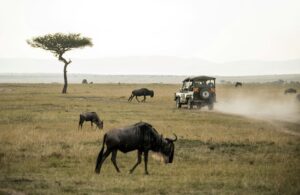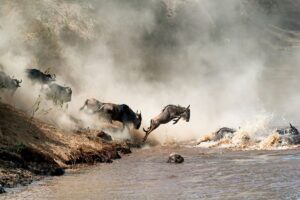Imagine a vast herd of wildebeest disappearing into the horizon. Moving in unison, they kick up dust on their way forward, resolute in their mission to traverse the land in search of fresh grazing spaces and watering holes. A Great Migration safari across the plains of the Serengeti in Tanzania and into the Masai Mara in Kenya is a wildlife experience unlike any other. Leaping across rivers inhabited by waiting crocodiles and with land predators like lions hot on their heels, the wildebeest migration is one of the most exciting events on the safari calendar. With the help of East Africa experts, we’ve answered 13 of the most popular questions regarding wildebeest migration safaris.

1. How Long Should a Safari Be to See the Migration?
One week is the minimum amount of time we recommend for a migration safari. However, your budget dictates how long or short your safari is. At the end of the day, the more time you spend on safari, the better your chances of witnessing dramatic events during the migration. Discover Africa’s safari planners will create the perfect Great Migration safari itinerary for you!
2. Is it Better to Go to the Masai Mara or Serengeti to See the Migration?
Either a Tanzania migration safari or a Kenya migration safari is an incredible way to see the wildebeest herds. The migration can be found on the Tanzanian side of the Mara River at the beginning of the year; huge numbers of wildebeest cross into the Masai Mara between late July and October. During river crossings, wildebeest dodge crocodiles as they make their way to the other side – a quintessential Great Migration experience. You could combine trips to the Serengeti and the Masai Mara for the ultimate East African safari.

3. Does it Get Overcrowded Around Migration Time?
Yes, the Great Migration is one of the most popular African safari experiences, so during peak times (like river crossings), parks can get full and accommodations are fully booked in advance.
4. How Much Can I Expect to Pay for a Great Migration Safari?
The cost of a Great Migration safari can depend on certain factors, including your choice of accommodation, when you plan on travelling, and the length of your holiday. A mid-range safari in Tanzania during high season can start at around $1,000 per person, per night sharing; a luxury Tanzania safari during high season can be over $2,500 per person, per night sharing. In Kenya, a mid-range safari in the high season can start at $900 per person, per night sharing; a luxury Kenya safari can exceed $2,250 per person, per night sharing.
5. Is it Possible to Get Accommodation Close to the Migration?
Yes, it is possible. There are certain key areas where we know the herds will pass because of traditional migration routes and also because the herd needs access to drinking water. That means we can predict fairly accurately where the herds will be, especially when they are not mobile during calving season in the Serengeti.
Each of these areas has different levels of accommodation and the earlier you speak to your travel expert, the more options you will have.

6. What Wildlife Can be Seen on a Migration Safari?
Wildebeest may be the stars of the Great Migration show, but other plains game like zebras, Thomson’s gazelles, and elands embark on the migratory journey, too. These travelling herbivores attract predators like lions, hyenas, leopards, cheetahs, and wild dogs. It’s also not uncommon to come across giraffes, elephants, buffalo, and hippos while on a migration safari in Kenya or Tanzania, too.
7. When Does the Migration Start and Finish?
The wildebeest start their journey in the southern Serengeti after they give birth to their young between January and March. They reach the central Serengeti between April and May. Herds generally enter the Masai Mara anytime from late July onwards and return to the Serengeti towards the end of October and November. HerdTracker shows you where the migration is in real-time and our interactive wildebeest migration map predicts possible forecasts of where the migration might be at a given time.

8. What Else Can a Migration Safari Be Combined With?
After a Great Migration safari in East Africa, spend a few days enjoying the island paradise of Zanzibar. This archipelago, just off the coast of Tanzania, boasts pristine white sand beaches and sublime snorkelling and diving spots. Also, the best time to go to Zanzibar coincides with the high season of the Great Migration.
9. Can You Go on a Hot Air Balloon Ride Over the Migration?
Yes, you can go on a hot air balloon safari to see migratory herds from above. It’s always advised to book in advance, which we will do for you once you have your travel dates. We would recommend a Masai Mara balloon safari from August to the end of September and a Serengeti balloon safari in June and December to March. The western Serengeti corridor can be enjoyed from a hot air balloon during late June and July when spotting the herds is easy.

10. What Vaccinations are Needed for a Safari in East Africa?
Normally, it’s recommended to take malaria prophylactics and get vaccinated against yellow fever when travelling to East Africa.
11. Is it Better to Visit the Masai Mara or the Serengeti First?
It is generally regarded that you should visit the Serengeti side before going across to the Masai Mara. This is true for the beginning of the river crossing season (late July to the end of August). You would, however, swap those two around during the end of the season when the herds start crossing back (between October and November).
12. When to Book to Escape the Crowds?
For a more secluded safari experience in Tanzania, we recommend visiting the Serengeti during the green season, between January and late March. At this time of the year, the wildebeest give birth to their young, so you could see wobbly newborns take their first steps before the herds begin their journey.
13. How Long in Advance Should You Book a Great Migration Safari?
When it comes to planning an African safari, booking in advance is essential. It’s recommended that you book at least one year to 18 months in advance for a Great Migration safari during the dry season. If you want to go during the green season, it’s recommended to book your trip six to 10 months in advance. The earlier you start planning, the more options there are for you. Advance booking not only guarantees availability at the most sought-after camps and lodges but also allows you to curate your ideal itinerary.
A Great Migration safari is a wilderness experience like no other. Sightings of the vast herds of wildebeest travelling across the spectacular locations of the Serengeti or Masai Mara and crossing rivers will stay with you forever and entrench Africa as a favourite holiday destination.
Author: Chrizaan Troch
Published: 14 March 2019